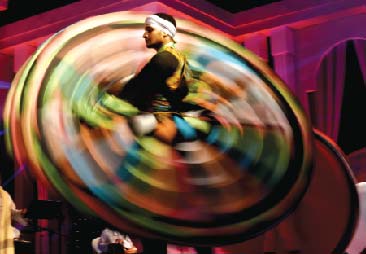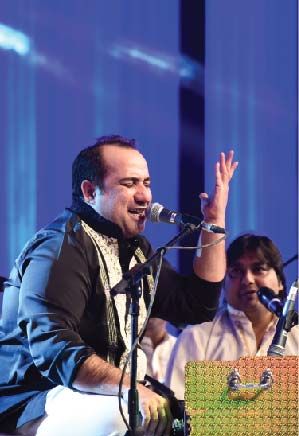Aidha Cader discusses the Sufi Festival and more
Photos: Sabrina Sultana Islam
With my ever-present fascination for Islamic art, the Dhaka Sufi Music Festival was a great chance for me to be part of an artistic and cultural extravaganza. It was a treat I was looking forward to; when the day finally arrived I realised that the venue was farther away than what I had anticipated. The traffic was hectic on the first two nights and we missed the first acts. On the final day the roads were less congested as the looming hartal woes ensured that most people stayed home.
I enjoyed the Tunisian and the Egyptian performances the most. They had the perfect mix of performance art and commercialism bound by Sufi music. I had seen similar mystic musicals in Konya, Turkey- the birthplace of the Whirling Dervishes and also in Cairo, Egypt. In comparison, I found the acts overseas to be more authentic. However, as a travelling troupe performing in front of a diverse international audience, these acts had the right showmanship. Many attended the final night to watch and listen to Rahat Fateh Ali Khan, the legendary Qawwali singer. It was an electrifying performance. He delivered what the majority wanted- Bollywood music! It was enjoyable, but did it fit the tag? The night before I saw Javed Ali enthrall the crowd, though not as much, to a series of Bollywood songs as well. Nonetheless, I have to admit I am a fan of Bollywood pop and often unwind at night flicking through 9XM, MTV and Zoom. Henceforth, I did not feel compelled to complain as much. In all respect, it was an entertaining event.
A salute to the organisers who managed to host such legends and give us three nights of live music. Dhaka needed the escapism, be it in Sufi music or Bollywood entertainment, the festival fulfilled that aspect.
Art is a great way to break down the shackles of religion and race. The event was able to incorporate artists from Spain, Denmark, Maghreb, South Asia and Africa, bringing them into the realm of Sufi music with significant diversity within each performance. It also highlighted the spectrum of Islamic art, it’s extent over fourteen hundred years, spanning four continents that continue to grow and vary. This was a refreshing concept to appreciate Islamic art. The idea of Islamic art in music or other forms is wide and fascinating, which prompted me to follow an online course conducted by the Oxford University, UK on Islamic Art and Architecture. It opened up my world to the vast realm of what is deemed Islamic art. It also highlighted the influence Islamic art had borrowed and adapted Christian, Persian, Chinese, Hindu, and African cultures. Furthermore, what is deemed today as Islamic culture is a mix of many nations; it’s people and places and trends the pre date Islam.
Today, some are paranoid by the trend of Arabisation that seems to be sweeping, especially the way women choose to dress. Critics feel the erosion of their indigenous culture. However, culture is fluid and will influence people. We live in a global world where travelling overseas is affordable, where a click on your phone will expose you to cultures beyond your imagination. In our ever-shrinking world the boundaries that divide us are disappearing and many are growing more accustomed to lose their tag that defines them, be it in ethnicity, race or religion. As in my case, many a time I have been asked if I am trying to Arabise by choosing to where the hijab. However, on the contrary it does not make me less patriotic that I choose to dress in a particular way or speak a language that is not my mother tongue. It simply means that as a global citizen, we have the flexibility to pick and choose aspects- be it in my clothes, language, food, entertainment or art. Our ability to make such choices on our own accord is a right we have and societies, pluralistic or otherwise have very little choice in the matter.
Back in time

Sufism is an Islamic movement whose followers seek to find the divine truth through direct encounters with God. Sufism arose during Islam’s golden age from 9th to 10thCE., as an ascetic movement. Sufis have traditionally taken vows of poverty, celibacy and developed religious practices focusing on strict self-control that enable both psychological and mystical. Sufi music is the devotional music of this order and inspired by the works of Sufi poets, the likes of Rumi, Hafiz, Bulleh Shah, Amir Khusrow and Khwaja Ghulam Farid.
The coffee tale

A beverage made from the wild coffee plant seems to have been first drunk by shepherds on the Ethiopian plateau. The earliest cultivation of coffee was in Yemen and they gave its Arabic name qahwa, from which the words coffee and cafe are both derived. Qahwa originally meant wine, and Sufi mystics in Yemen used coffee as an aid to concentrate during chanting rituals. By 1414, it was known in Mecca and spread to Egypt, Syria and Istanbul. It was still associated with Sufism, and a cluster of coffee houses first took root in Cairo. In Mecca, Cairo and Istanbul attempts were made to ban it by religious authorities. Islamic scholars were convinced the effects of coffee were similar to those of alcohol. As coffee houses grewand they also became a place where men would gather to talk, listen to poets and play games like chess and backgammon. It became a focus for intellectual life and could be seen as a rival to the mosque as a meeting place. However, all attempts at banning coffee failed and the religious scholars eventually declared the drink permissible. Coffee spread to Europe through the expansion of the Ottoman Empire and via trade links.


